formerly eScholarship Editions


|
|
|
|
Browse by Title
All Titles | Public Titles
A | B | C | D | E | F | G | H | I | J | K | L | M | N | O | P | Q | R | S | T | U | V | W | Y | Z | OTHERYour request for titles beginning with S found 159 book(s). | Modify Search | Displaying 61 - 80 of 159 book(s) | |
| 61. | 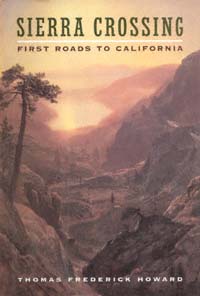 | Title: Sierra crossing: first roads to California Author: Howard, Thomas Frederick 1946- Published: University of California Press, 1998 Subjects: California and the West | Californian and Western History | Geography | United States History Publisher's Description: A critical era in California's history and development - the building of the first roads over the Sierra Nevada - is thoroughly and colorfully documented in Thomas Howard's fascinating book. During California's first two decades of statehood (1850-1870), the state was separated from the east coast by a sea journey of at least six weeks. Although Californians expected to be connected with the other states by railroad soon after the 1849 Gold Rush, almost twenty years elapsed before this occurred. Meanwhile, various overland road ventures were launched by "emigrants," former gold miners, state government officials, the War Department, the Interior Department, local politicians, town businessmen, stagecoach operators, and other entrepreneurs whose alliances with one another were constantly shifting. The broad landscape of international affairs is also a part of Howard's story.Constructing roads and accumulating geographic information in the Sierra Nevada reflected Washington's interest in securing the vast western territories formerly held by others. In a remarkably short time the Sierra was transformed by vigorous exploration, road-promotion, and road-building. Ox-drawn wagons gave way to stagecoaches able to provide service as fine as any in the country. Howard effectively uses diaries, letters, newspaper stories, and official reports to recreate the human struggle and excitement involved in building the first trans-Sierra roads. Some of those roads have become modern highways used by thousands every day, while others are now only dim traces in the lonely backcountry. [brief] Similar Items |
| 62. | 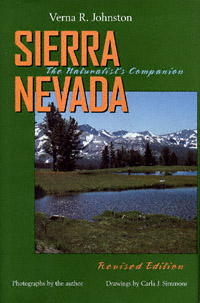 | Title: Sierra Nevada: the naturalist's companion Author: Johnston, Verna R Published: University of California Press, 1998 Subjects: Environmental Studies | Environmental Studies | California and the West Publisher's Description: All lovers of the mountains will welcome Verna Johnston's new and completely updated edition of her classic, Sierra Nevada , originally published in 1970. A professional biologist, veteran ornithologist, and well-known wildlife photographer, Johnston is the perfect guide for a natural-history trip into the Sierra. Regardless of how one explores the magnificent 400-mile-long mountain range, on foot or by car, in an armchair or a classroom, this is the book to have.Beginning with the western foothills, Johnston evokes a vivid picture of the varied plant and animal life encountered as the elevation increases, tops the crest, and drops to the more precipitous, arid eastern Sierra slope. The reader is taken through chaparral and mountain meadows, pine and fir forests, granite expanses and snowy peaks. Johnston writes of the Native Americans' uses and stewardship of the land, the role of fire in forest ecology, the eras of sheep herders and loggers, the work of John Muir and other preservationists, and the battles to save Mono Lake and Lake Tahoe. Her lifetime of field experience and discovery offers intimate observations of rarely recorded events: the courtship of the Sierra Nevada salamander, a wolverine attacking two bears, a fight to the death between a skink and a scorpion.Many changes have occurred in the Sierra since the first edition of this book was published, including acid snow, tensions involving human and cougar habitats, and an ominous drop in amphibian populations. Johnston documents these events and updates the ecological research in the rich, evocative writing style that makes her book a naturalist's treasure. This is a guide to the Sierra Nevada for the next millennium. [brief] Similar Items |
| 63. | 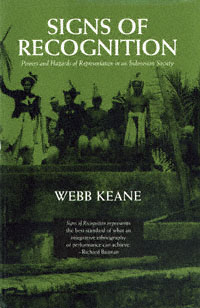 | Title: Signs of recognition: powers and hazards of representation in an Indonesian society Author: Keane, Webb 1955- Published: University of California Press, 1997 Subjects: Anthropology | Asian Studies | Cultural Anthropology Publisher's Description: Webb Keane argues that by looking at representations as concrete practices we may find them to be thoroughly entangled in the tensions and hazards of social existence. This book explores the performances and transactions that lie at the heart of public events in contemporary Anakalang, on the Indonesian island of Sumba. Weaving together sharply observed narrative, close analysis of poetic speech and valuable objects, and far-reaching theoretical discussion, Signs of Recognition explores the risks endemic in representational practices. An awareness of risk is embedded in the very forms of ritual speech and exchange. The possibilities for failure and slippage reveal people's mutual vulnerabilities and give words and things part of their power. Keane shows how the dilemmas posed by the effort to use and control language and objects are implicated with general problems of power, authority, and agency. He persuades us to look differently at ideas of voice and value. Integrating the analysis of words and things, this book contributes to a wide range of fields, including linguistic anthropology, cultural studies, social theory, and the studies of material culture, art, and political economy. [brief] Similar Items |
| 64. |  | Title: Silence at Boalt Hall: the dismantling of affirmative action Author: Guerrero, Andrea 1970- Published: University of California Press, 2002 Subjects: American Studies | Anthropology | Sociology | African American Studies | Asian American Studies | Politics | Gender Studies | Law | Politics | Politics Publisher's Description: In 1995, in a marked reversal of progress in the march toward racial equity, the Board of Regents voted to end affirmative action at the University of California. One year later the electorate voted to do the same across the state of California. Silence at Boalt Hall is the thirty-year story of students, faculty, and administrators struggling with the politics of race in higher education at U.C. Berkeley's prestigious law school - one of the first institutions to implement affirmative action policies and one of the first to be forced to remove them. Andrea Guerrero is a member of the last class of students admitted to Boalt Hall under the affirmative action policies. Her informed and passionate journalistic account provides an insider's view into one of the most pivotal and controversial issues of our time: racial diversity in higher education. Guerrero relates the stories of those who benefited from affirmative action and those who suffered from its removal. She shows how the "race-blind" admission policies at Boalt have been far from race-neutral and how the voices of underrepresented minority students have largely disappeared. A hushed silence - the silence of students, faculty, and administrators unwilling and unable to discuss the difficult issues of race - now hangs over Boalt and many institutions like it, Guerrero claims. As the legal and sociopolitical battles over affirmative action continue on a number of consequential fronts, this book provides a rich and engrossing perspective on many facets of this crucial question. [brief] Similar Items |
| 65. | 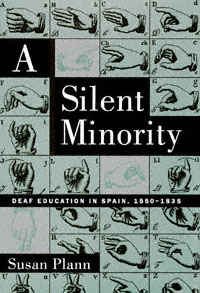 | Title: A silent minority: deaf education in Spain, 1550-1835 Author: Plann, Susan Published: University of California Press, 1997 Subjects: History | Language and Linguistics | Medieval History | European History | Education | European Studies | Medieval Studies | Cultural Anthropology | Cultural Anthropology Publisher's Description: This timely, important, and frequently dramatic story takes place in Spain, for the simple reason that Spain is where language was first systematically taught to the deaf. Instruction is thought to have begun in the mid-sixteenth century in Spanish monastic communities, where the monks under vows of silence employed a well-established system of signed communications. Early in the 1600s, deaf education entered the domain of private tutors, laymen with no use for manual signs who advocated oral instruction for their pupils. Deaf children were taught to speak and lip-read, and this form of deaf education, which has been the subject of controversy ever since, spread from Spain throughout the world.Plann shows how changing conceptions of deafness and language constantly influenced deaf instruction. Nineteenth-century advances brought new opportunities for deaf students, but at the end of what she calls the preprofessional era of deaf education, deaf people were disempowered because they were barred from the teaching profession. The Spanish deaf community to this day shows the effects of the exclusion of deaf teachers for the deaf.The questions raised by Plann's narrative extend well beyond the history of deaf education in Spain: they apply to other minority communities and deaf cultures around the world. At issue are the place of minority communities within the larger society and, ultimately, our tolerance for human diversity and cultural pluralism. [brief] Similar Items |
| 66. | 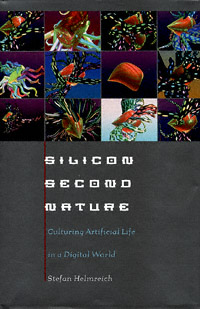 | Title: Silicon second nature: culturing artificial life in a digital world Author: Helmreich, Stefan 1966- Published: University of California Press, 1998 Subjects: Science | Computer Science | Biology | Technology and Society | Social Theory | Cultural Anthropology | California and the West Publisher's Description: Silicon Second Nature takes us on an expedition into an extraordinary world where nature is made of bits and bytes and life is born from sequences of zeroes and ones. Artificial Life is the brainchild of scientists who view self-replicating computer programs - such as computer viruses - as new forms of life. Anthropologist Stefan Helmreich's look at the social and simulated worlds of Artificial Life - primarily at the Santa Fe Institute, a well-known center for studies in the sciences of complexity - introduces readers to the people and programs connected with this unusual hybrid of computer science and biology.When biology becomes an information science, when DNA is downloaded into virtual reality, new ways of imagining "life" become possible. Through detailed dissections of the artifacts of Artifical Life, Helmreich explores how these novel visions of life are recombining with the most traditional tales told by Western culture. Because Artificial Life scientists tend to see themselves as masculine gods of their cyberspace creations, as digital Darwins exploring frontiers filled with primitive creatures, their programs reflect prevalent representations of gender, kinship, and race, and repeat origin stories most familiar from mythical and religious narratives.But Artificial Life does not, Helmreich says, simply reproduce old stories in new software. Much like contemporary activities of cloning, cryonics, and transgenics, the practice of simulating and synthesizing life in silico challenges and multiplies the very definition of vitality. Are these models, as some would claim, actually another form of the real thing? Silicon Second Nature takes Artifical Life as a symptom and source of our mutating visions of life itself. [brief] Similar Items |
| 67. | 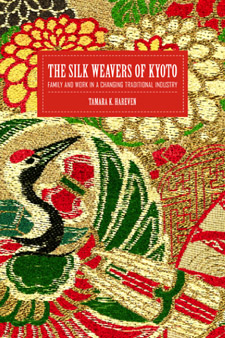 | Title: The silk weavers of Kyoto: family and work in a changing traditional industry Author: Hareven, Tamara K Published: University of California Press, 2003 Subjects: Sociology | Anthropology | Asian Studies | Asian History | Labor Studies Publisher's Description: The makers of obi, the elegant and costly sash worn over kimono in Japan, belong to an endangered species. These families of manufacturers, weavers, and other craftspeople centered in the Nishijin weaving district of Kyoto have practiced their demanding craft for generations. In recent decades, however, as a result of declining markets for kimono, they find their livelihood and pride harder to sustain. This book is a poignant exploration of a vanishing world. Tamara Hareven integrates historical research with intensive life history interviews to reveal the relationships among family, work, and community in this highly specialized occupation. Hareven uses her knowledge of textile workers' lives in the United States and Western Europe to show how striking similarities in weavers' experiences transcend cultural differences. These very rich personal testimonies, taken over a decade and a half, provide insight into how these men and women have juggled family and work roles and coped with insecurities. Readers can learn firsthand how weavers perceive their craft and how they interpret their lives and view the world around them. With rare immediacy, The Silk Weavers of Kyoto captures a way of life that is rapidly disappearing. [brief] Similar Items |
| 68. | 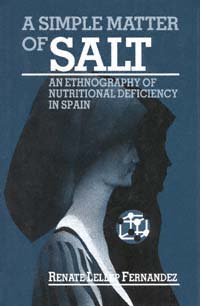 | Title: A simple matter of salt: an ethnography of nutritional deficiency in Spain Author: Fernandez, Renate Lellep Published: University of California Press, 1990 Subjects: Anthropology | Medical Anthropology Similar Items |
| 69. | 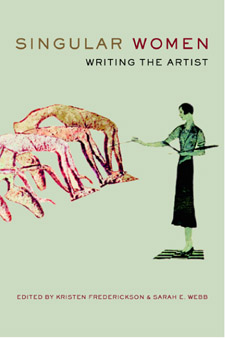 | Title: Singular women: writing the artist Author: Frederickson, Kristen 1965- Published: University of California Press, 2003 Subjects: Art | Art History | Art Criticism | Art Theory | Women's Studies Publisher's Description: In this groundbreaking volume, contemporary art historians - all of them women - probe the dilemmas and complexities of writing about the woman artist, past and present. Singular Women proposes a new feminist investigation of the history of art by considering how a historian's theoretical approach affects the way in which research progresses and stories are told. These thirteen essays on specific artists, from the Renaissance to the present day, address their work and history to examine how each has been inserted into or left out of the history of art. The authors go beyond an analysis of the past to propose new strategies for considering the contributions of women to the visual arts, strategies that take into account the idiosyncratic, personal, and limited rhetoric that confines all writers. [brief] Similar Items |
| 70. | 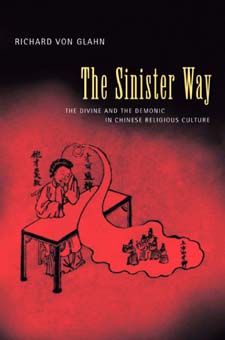 | Title: The sinister way: the divine and the demonic in Chinese religious culture Author: Von Glahn, Richard Published: University of California Press, 2004 Subjects: History | Religion | Asian History | China | Anthropology Publisher's Description: The most striking feature of Wutong, the preeminent God of Wealth in late imperial China, was the deity's diabolical character. Wutong was perceived not as a heroic figure or paragon of noble qualities but rather as an embodiment of humanity's basest vices, greed and lust, a maleficent demon who preyed on the weak and vulnerable. In The Sinister Way, Richard von Glahn examines the emergence and evolution of the Wutong cult within the larger framework of the historical development of Chinese popular or vernacular religion - as opposed to institutional religions such as Buddhism or Daoism. Von Glahn's study, spanning three millennia, gives due recognition to the morally ambivalent and demonic aspects of divine power within the common Chinese religious culture. [brief] Similar Items |
| 71. | 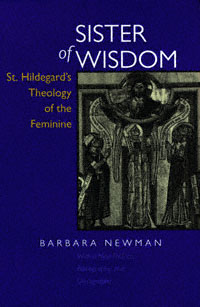 | Title: Sister of wisdom: St. Hildegard's theology of the feminine Author: Newman, Barbara 1953- Published: University of California Press, 1998 Subjects: History | Religion | Gender Studies | Women's Studies | Intellectual History | Medieval Studies Publisher's Description: Barbara Newman reintroduces English-speaking readers to an extraordinary and gifted figure of the twelfth-century renaissance. Hildegard of Bingen (1098-1179) was mystic and writer, musician and preacher, abbess and scientist who used symbolic theology to explore the meaning of her gender within the . . . [more] Similar Items |
| 72. |  | Title: Siting translation: history, post-structuralism, and the colonial context Author: Niranjana, Tejaswini 1958- Published: University of California Press, 1992 Subjects: Postcolonial Studies | Literary Theory and Criticism | Southeast Asia | Cultural Anthropology Publisher's Description: The act of translation, Tejaswini Niranjana maintains, is a political action. Niranjana draws on Benjamin, Derrida, and de Man to show that translation has long been a site for perpetuating the unequal power relations among peoples, races, and languages. The traditional view of translation underwritten by Western philosophy helped colonialism to construct the exotic "other" as unchanging and outside history, and thus easier both to appropriate and control.Scholars, administrators, and missionaries in colonial India translated the colonized people's literature in order to extend the bounds of empire. Examining translations of Indian texts from the eighteenth century to the present, Niranjana urges post-colonial peoples to reconceive translation as a site for resistance and transformation. [brief] Similar Items |
| 73. | 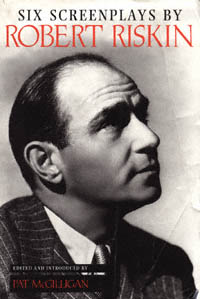 | Title: Six screenplays Author: Riskin, Robert Published: University of California Press, 1997 Subjects: Cinema and Performance Arts | Film Publisher's Description: Screenwriter Robert Riskin (1897-1955) was a towering figure even among the giants of Hollywood's Golden Age. Known for his unique blend of humor and romance, wisecracking and idealism, Riskin teamed with director Frank Capra to produce some of his most memorable films. Pat McGilligan has collected six of the best Riskin scripts: Platinum Blonde (1931), American Madness (1932), It Happened One Night (1934), Mr. Deeds Goes to Town (1936), Lost Horizon (1937), and Meet John Doe (1941). All of them were directed by Capra, and although Capra's work has been amply chronicled and celebrated, Riskin's share in the collaboration has been overlooked since his death. McGilligan provides the "backstory" for the forgotten half of the team, indispensable counterpoint to the director's self-mythologizing autobiography - and incidentally the missing link in any study of Capra's career.Riskin's own career, although interrupted by patriotic duty and cut short by personal tragedy, produced as consistent, entertaining, thoughtful, and enduring a body of work as any Hollywood writer's. Those who know and love these vintage films will treasure these scripts. McGilligan's introduction offers new information and insights for fans, scholars, and general readers. [brief] Similar Items |
| 74. | 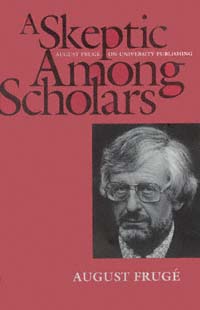 | Title: A skeptic among scholars: August Frugé on university publishing Author: Frugé, August 1909- Published: University of California Press, 1993 Subjects: History | Californian and Western History | Reference | Publishing Publisher's Description: When August Frugé joined the University of California Press in 1944, it was part of the University's printing department, publishing a modest number of books a year, mainly monographs by UC faculty members. When he retired as director 32 years later, the Press had been transformed into one of the largest, most distinguished university presses in the country, publishing more than 150 books annually in fields ranging from ancient history to contemporary film criticism, by notable authors from all over the world. August Frugé's memoir provides an exciting intellectual and topical story of the building of this great press. Along the way, it recalls battles for independence from the University administration, the Press's distinctive early style of book design, and many of the authors and staff who helped shape the Press in its formative years. [brief] Similar Items |
| 75. |  | Title: Slide Mountain, or, The folly of owning nature Author: Steinberg, Theodore 1961- Published: University of California Press, 1995 Subjects: Law | Environmental Studies | United States History | American Studies Publisher's Description: The drive to own the natural world in twentieth-century America seems virtually limitless. Signs of this national penchant for possessing nature are everywhere - from suburban picket fences to elaborate schemes to own underground water, clouds, even the ocean floor.Yet, as Theodore Steinberg demonstrates in this compelling, witty look at Americans' attempts to master the environment, nature continually turns these efforts into folly. In a rich, narrative style recalling the work of John McPhee, Steinberg tours America to explore some of the more unusual dilemmas that have arisen in our struggle to possess nature.Beginning along the Missouri River, Steinberg recounts the battle for three thousand acres of land the river carved from a Nebraska Indian reservation and deposited in Iowa. Then he travels to Louisiana, where an army of lawyers butted heads over whether Six Mile Lake was actually a lake or a stream. He continues to Arizona to investigate who owned the underground, then to Pennsylvania's Blue Ridge Mountains to see who claimed the clouds. He ends in crowded New York City with Donald Trump's struggle for air rights.Americans' obsession with owning nature was immortalized by Mark Twain in the tale of Slide Mountain, where a landslide-prone Nevada peak turned the American dream of real estate into dust. In relating these modern-day "Slide Mountain" stories, Steinberg illuminates what it means to live in a culture of property where everything must have an owner. [brief] Similar Items |
| 76. |  | Title: Small property versus big government: social origins of the property tax revolt Author: Lo, Clarence Y. H Published: University of California Press, 1990 Subjects: Sociology | American Studies | Public Policy | Law | Sociology Publisher's Description: Tax reformers, take note. Clarence Lo's investigation of California's Proposition 13 and other tax reduction bills is both a tribute and a warning to people who get "mad as hell" and try to do something about being pushed around by government. Homeowners in California, faced with impossible property tax bills in the 1970s, got mad and pushed back, starting an avalanche that swept tax limitation measures into state after state. What we learn is that, although the property tax was slashed, two-thirds of the benefits went to business owners rather than homeowners.How did a crusade launched by homeowning consumers seeking tax relief end up as a pro-business, supply-side political program? To trace the transformation, Lo uses the firsthand recollections of 120 activists in the movement, going back to the 1950s. He shows how their protests were ignored, until a suburban alliance of upper-middle-class property owners and business owners took charge. It was the program of that latter group, not the plight of the moderate-income homeowner, which inspired tax revolts across the nation and shaped the economic policies of the Reagan administration. [brief] Similar Items |
| 77. |  | Title: Smallpox: the fight to eradicate a global scourge Author: Koplow, David A 1951- Published: University of California Press, 2003 Subjects: Politics | American Studies | Public Policy | Disease Publisher's Description: Though smallpox was eradicated from the planet two decades ago, recent terrorist acts have raised the horrific possibility that rogue states, laboratories, or terrorist groups are in possession of secret stockpiles of the virus that causes the disease, and may be preparing to unleash it on target populations. Because it is a far deadlier killer than other biological warfare agents such as anthrax, and because the universal vaccination against smallpox was halted decades ago, a smallpox attack today would be nothing short of catastrophic. This clear, authoritative study looks at the long and fascinating history of the virus, with an informative overview of the political, biological, environmental, medical, and legal issues surrounding the question of whether or not the virus should be exterminated. The only two known samples of the virus are currently stored in Atlanta and Russia. The World Health Organization has repeatedly scheduled their destruction - an action that would rid the planet of all publicly acknowledged smallpox strains forever. Opponents of this plan argue that by destroying these last samples we are denying the possibility that this unique virus could be turned to beneficial purposes in basic scientific research. Others see the stockpile as part of a deterrent against future germ attacks. Proponents of prompt eradication argue that scientists have already learned all they can from this particular virus, and that by destroying the stockpile we are preventing it from ever falling into the wrong hands. As a thirty-year veteran of arms control issues, David Koplow is uniquely suited to provide readers with an informed and well-considered understanding of the complexities involved in the handling of this deadly virus. [brief] Similar Items |
| 78. | 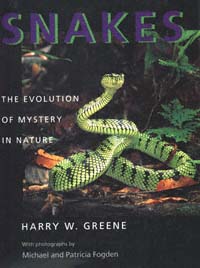 | Title: Snakes: the evolution of mystery in nature Author: Greene, Harry W 1945- Published: University of California Press, 1997 Subjects: Science | Biology | Natural History Publisher's Description: This is a book about some of nature's most alluring and forbidding creatures, written by a man with an abiding passion for snakes, as well as for science, the fate of the planet, and the wonder of life. Harry Greene presents every facet of the natural history of snakes - their diversity, evolution, and conservation - and at the same time makes a personal statement of why these animals are so compelling.This book provides an up-to-date summary of the biology of snakes on a global basis. Eight chapters are devoted to general biology topics, including anatomy, feeding, venoms, predation and defense, social behavior, reproduction, evolution, and conservation; eight chapters survey the major snake groups, including blindsnakes, boas, colubrids, stiletto snakes, cobras, sea snakes, and vipers. Details of particular interest, such as coral snake mimicry and the evolution of the0 rattle, are highlighted as special topics. Chapter introductory essays are filled with anecdotes that will tempt nonspecialists to read on, while the book's wealth of comprehensive information will gratify herpeto-culturalists and professional biologists.Greene's writing is clear, engaging, and full of appreciation for his subject. Michael and Patricia Fogden are known internationally for their outstanding work, and their stunning color photographs of snakes in their natural habitats are a brilliant complement to Greene's text. Here is a scientific book that provides accurate information in an accessible way to general readers, strongly advocates for a persecuted group of animals, encourages conservation - not just of snakes but of ecosystems - and credits science for enriching our lives. In helping readers explore the role of snakes in human experience, Greene and the Fogdens show how science and art can be mutual pathways to understanding. [brief] Similar Items |
| 79. | 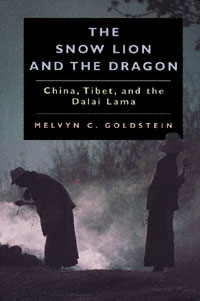 | Title: The snow lion and the dragon: China, Tibet, and the Dalai Lama Author: Goldstein, Melvyn C Published: University of California Press, 1997 Subjects: History | Politics | Asian History | China | Cultural Anthropology | Tibet Publisher's Description: Tensions over the "Tibet Question" - the political status of Tibet - are escalating every day. The Dalai Lama has gained broad international sympathy in his appeals for autonomy from China, yet the Chinese government maintains a hard-line position against it. What is the history of the conflict? Can the two sides come to an acceptable compromise? In this thoughtful analysis, distinguished professor and longtime Tibet analyst Melvyn C. Goldstein presents a balanced and accessible view of the conflict and a proposal for the future.Tibet's political fortunes have undergone numerous vicissitudes since the fifth Dalai Lama first ascended to political power in Tibet in 1642. In this century, a forty-year period of de facto independence following the fall of the Qing dynasty in 1911 ended abruptly when the Chinese Communists forcibly incorporated Tibet into their new state and began the series of changes that destroyed much of Tibet's traditional social, cultural, and economic system. After the death of Mao in 1976, the rise to power of Deng Xiaoping quickly produced a change in attitude in Beijing and a major initiative to negotiate with the Dalai Lama to solve the conflict. This failed. With the death of Deng Xiaoping, the future of Tibet is more uncertain than ever, and Goldstein argues that the conflict could easily erupt into violence.Drawing upon his deep knowledge of the Tibetan culture and people, Goldstein takes us through the history of Tibet, concentrating on the political and cultural negotiations over the status of Tibet from the turn of the century to the present. He describes the role of Tibet in Chinese politics, the feeble and conflicting responses of foreign governments, overtures and rebuffs on both sides, and the nationalistic emotions that are inextricably entwined in the political debate. Ultimately, he presents a plan for a reasoned compromise, identifying key aspects of the conflict and appealing to the United States to play an active diplomatic role. Clearly written and carefully argued, this book will become the definitive source for anyone seeking an understanding of the Tibet Question during this dangerous turning point in its turbulent history. [brief] Similar Items |
| 80. | 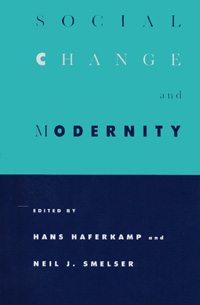 | Title: Social change and modernity Author: Haferkamp, Hans 1939- Published: University of California Press, 1992 Subjects: Politics | Politics Similar Items |